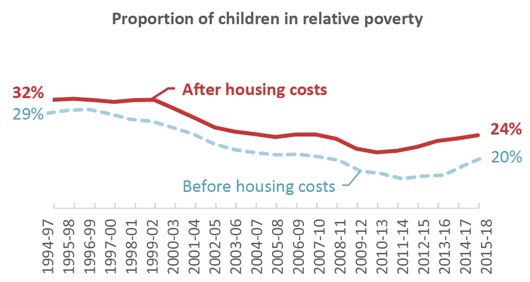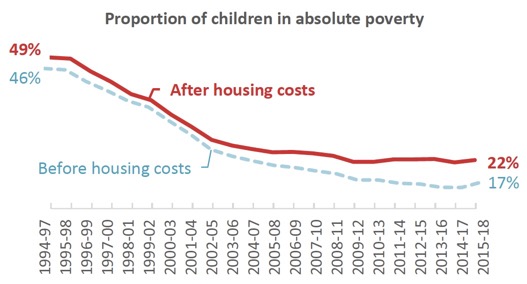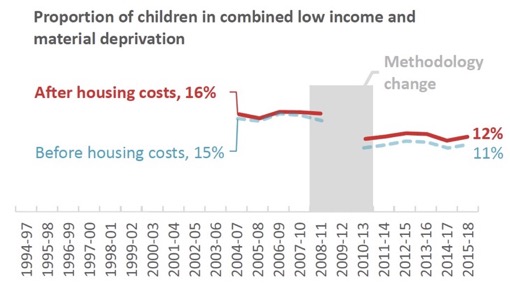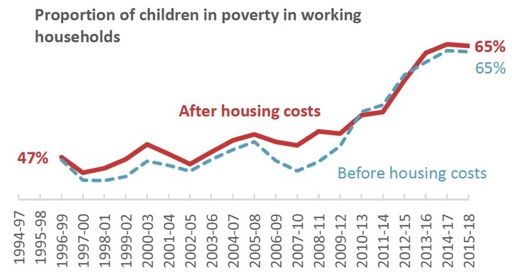Poverty and Income Inequality in Scotland 2015-18
Estimates of the number and proportion of people living in poverty in Scotland in 2015-18.
Children in poverty
Chart 3. Relative poverty rate for children slowly rising

It is estimated that 24% of children (240,000 children each year) were living in relative poverty after housing costs in 2015-18. This compares to 24% (230,000 children) in the previous period.
Before housing costs, it is estimated that 20% of children (200,000 children each year) were in relative poverty, compared to 19% previously.
Child poverty rates had been falling for many years, but began to rise again since 2010-13 (after housing costs) and 2011-14 (before housing costs).
The Child Poverty (Scotland) Act 2017 requires us to report annually on a number of child poverty measures. The latest single-year estimates can be found in the associated tables.
Chart 4. Absolute poverty rate for children stable

Absolute child poverty after housing costs remained at 22% (220,000 children each year) after a long, slow decrease.
Before housing costs, absolute child poverty was at 17% (170,000 children each year) compared to 15% in the previous period.
Absolute child poverty before housing costs had continued to decrease when absolute child poverty after housing costs already stagnated. As a result, the gap between absolute poverty before and after housing costs widened in recent years.
Chart 5. Children in combined material deprivation and low income broadly stable

It is estimated that 12% of children (120,000 children each year) were living in combined low income and material deprivation, after housing costs in 2015-18, similar to 2014-17. Before housing costs, this was 11% of children (110,000 children), compared to 10% in the previous period.
Combined low income and child material deprivation is an additional way of measuring living standards and refers to the inability of households to afford basic goods and activities that are seen as necessities in society.
More detail on this can be found in the Annex.
Material deprivation data has been collected since 2004. Due to a change in the methodology, it is not possible to compare the most recent years with years before 2010-13. The break in the time series indicates this change.
Chart 6. In-work poverty for children may be stabilising

It is estimated that in 2015-18, 65% of children in relative poverty after housing costs (160,000 children each year) were living in working households. This compares to 66% in the previous period. Before housing costs, 65% of children in poverty (130,000 children) were living in working households, the same proportion as in the previous period.
This data suggests that after a steady increase of in-work poverty since 2007-10, the rise of in-work poverty may begin to slow down or stabilise.
The terms ‘working’ and ‘in-work poverty’ here refer to paid employment only. In-work poverty refers to people living in households where at least one member of the household is in either full or part-time paid work, but where the household income is below the relative poverty threshold.
Contact
There is a problem
Thanks for your feedback